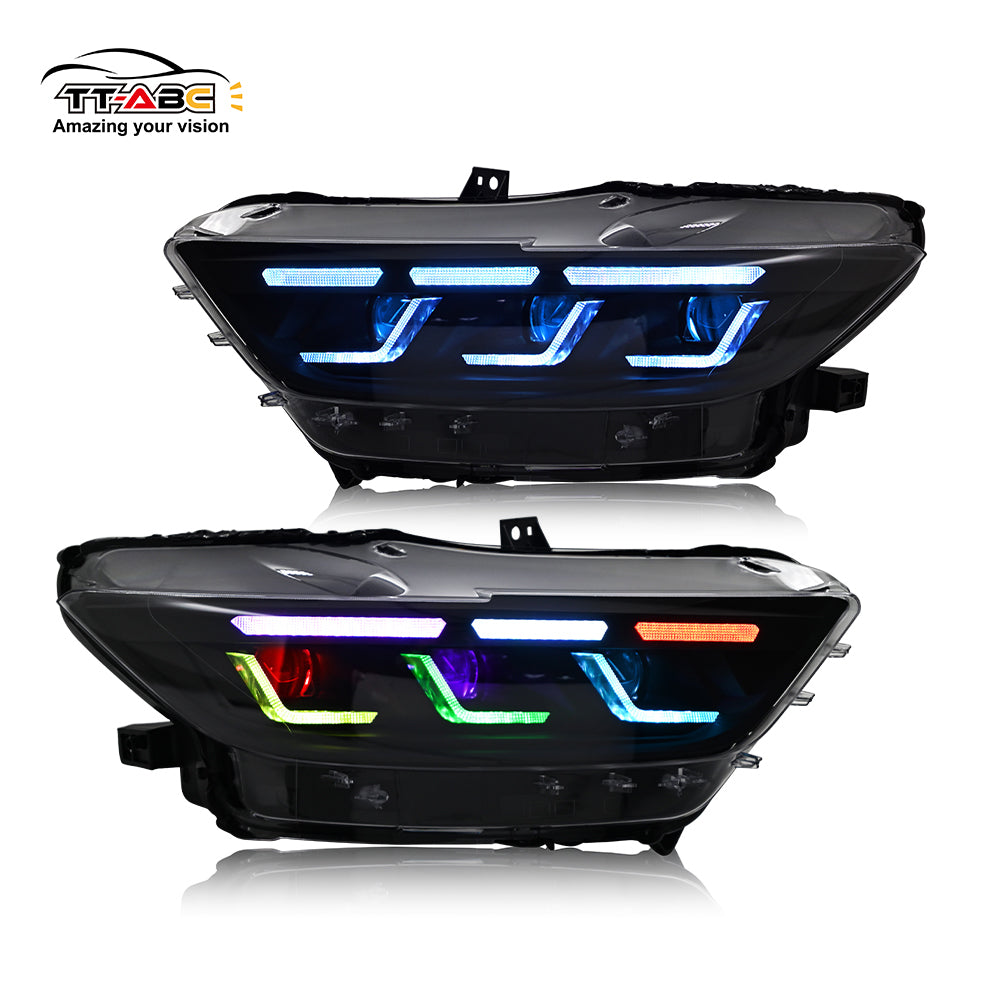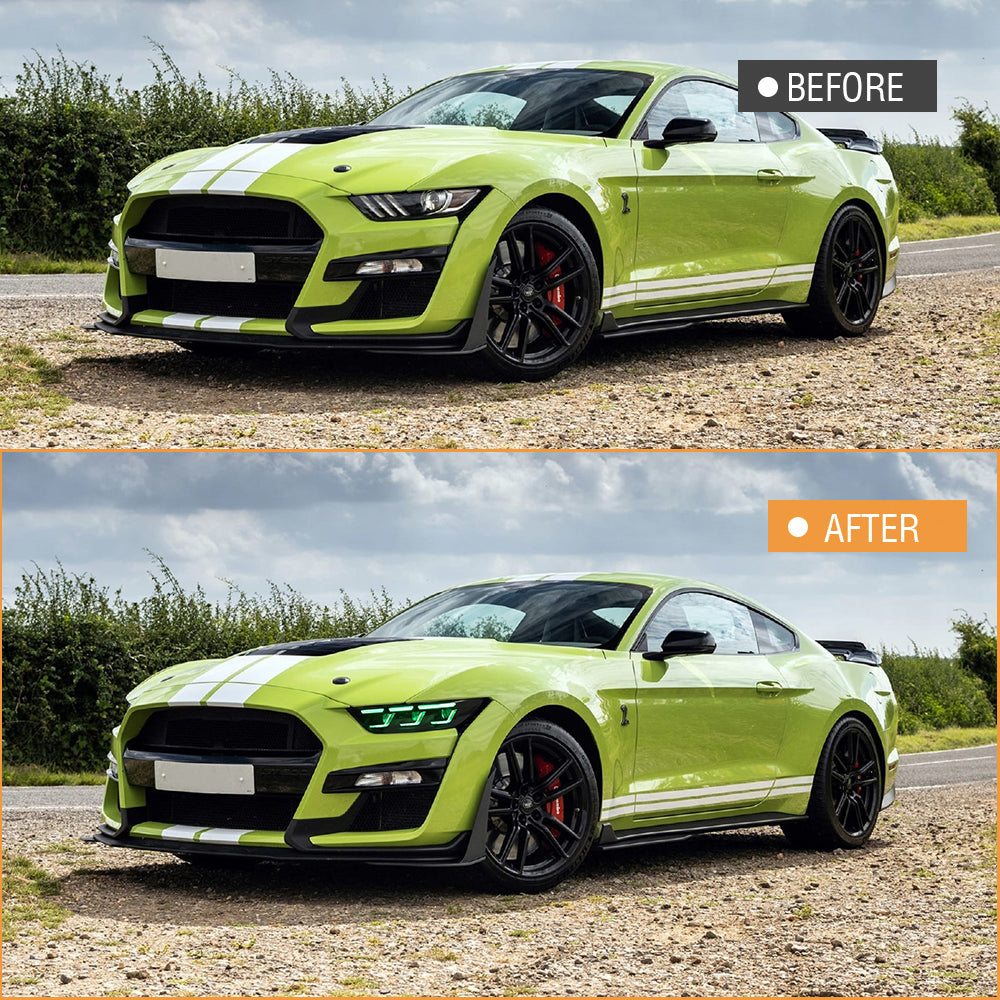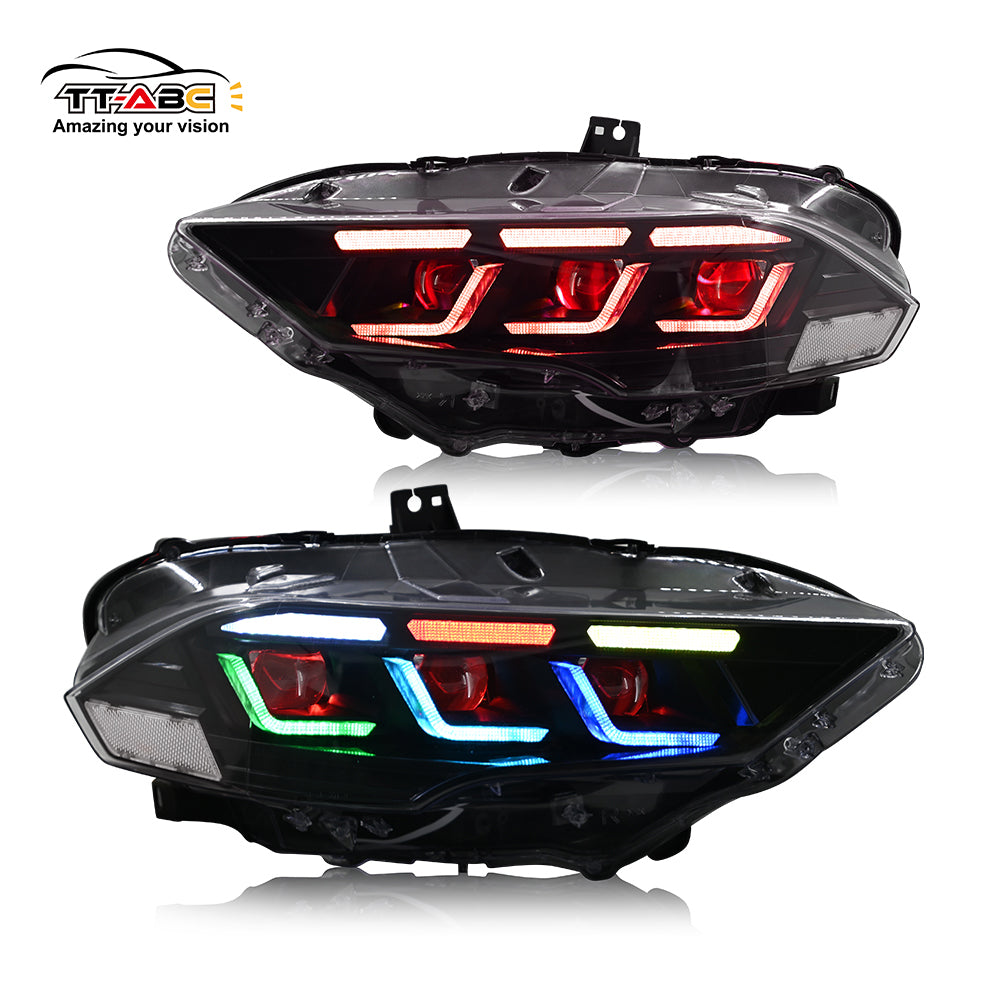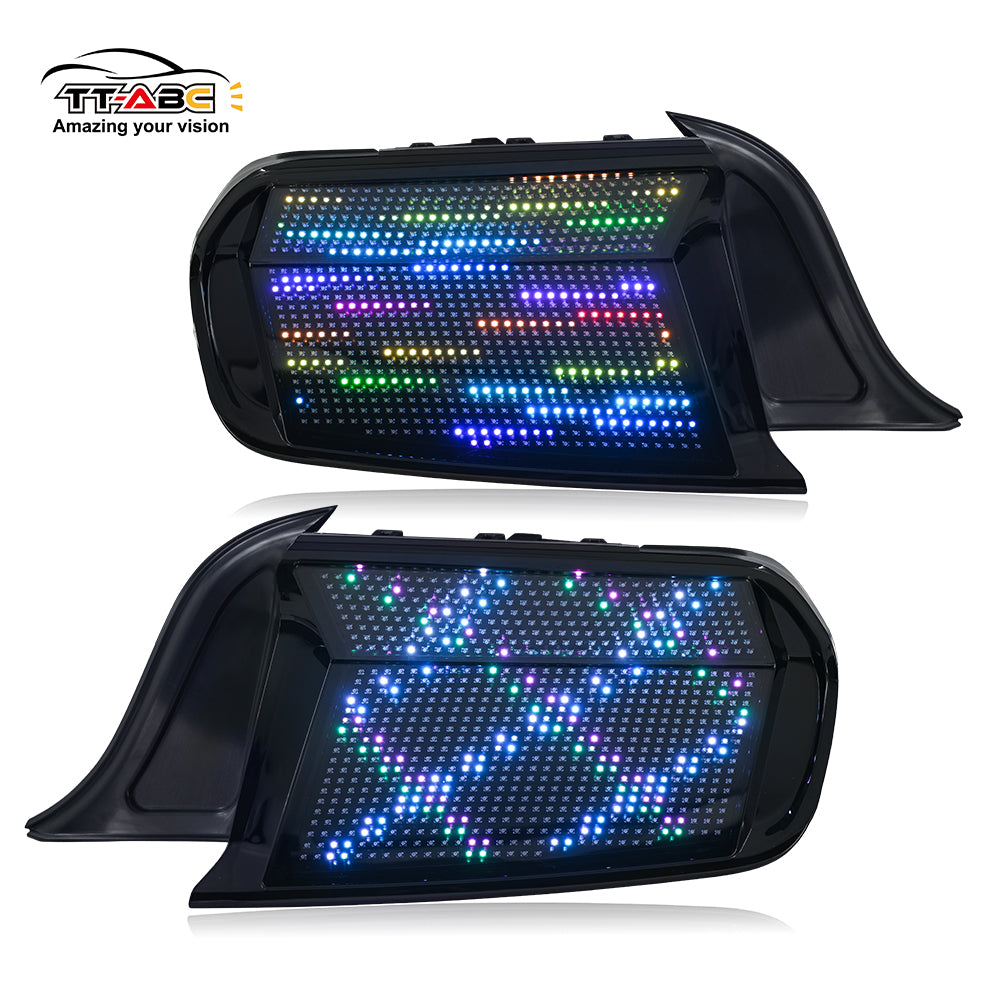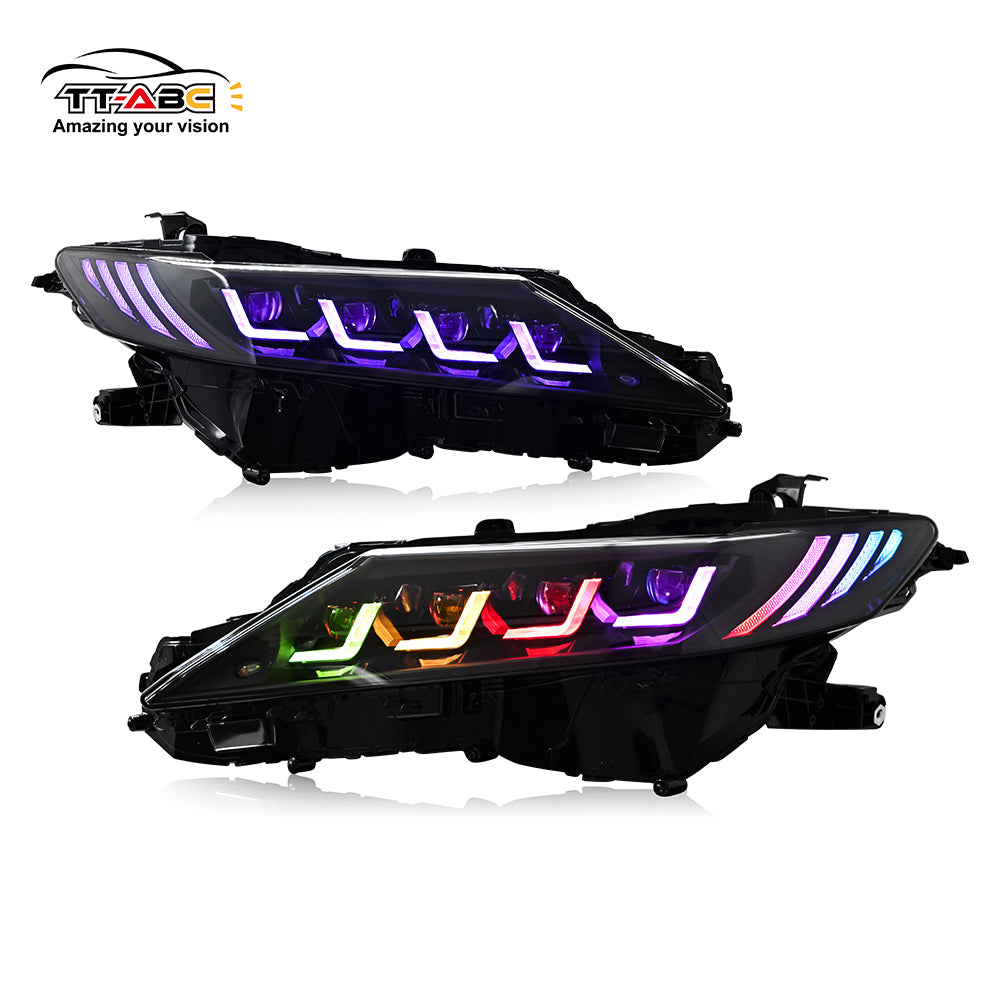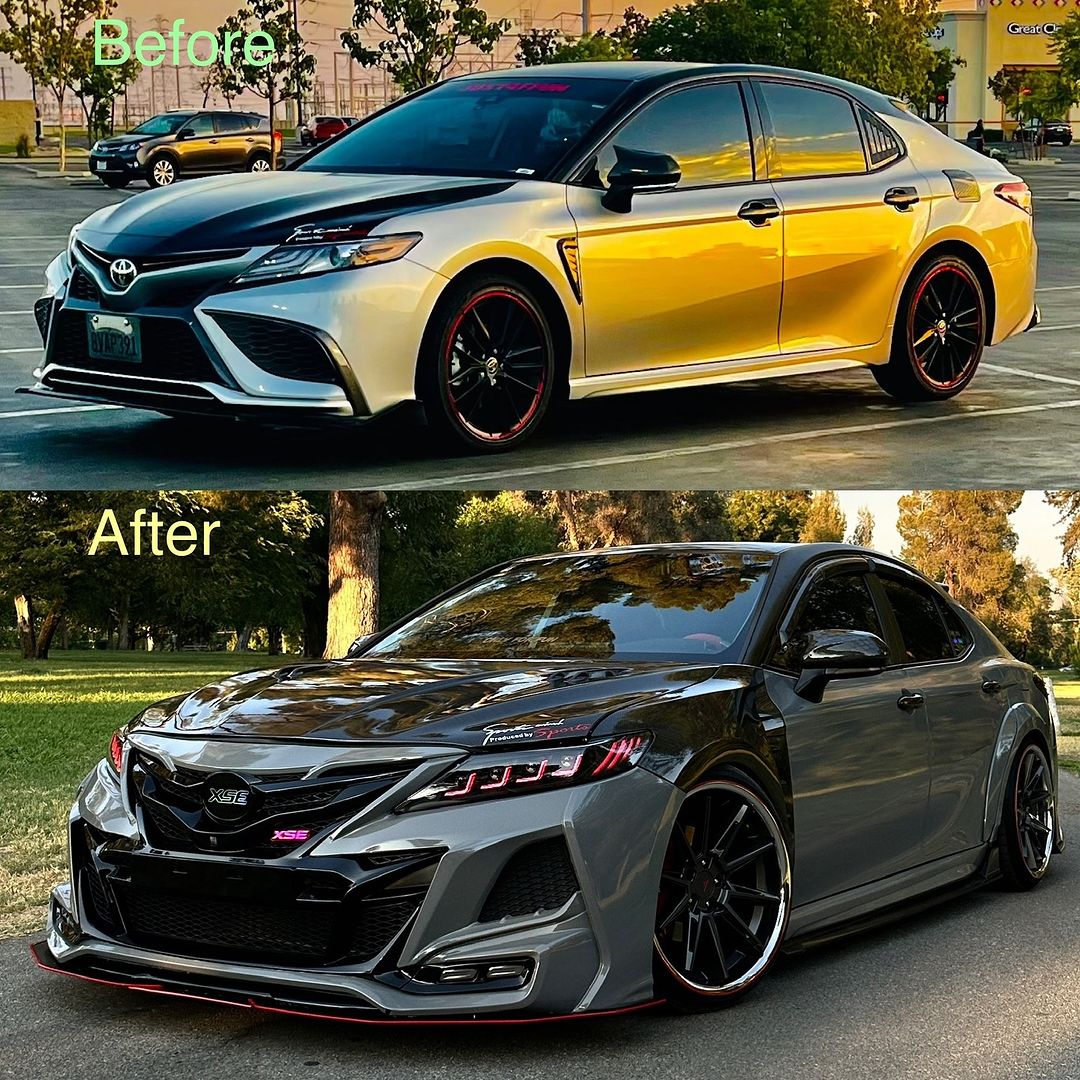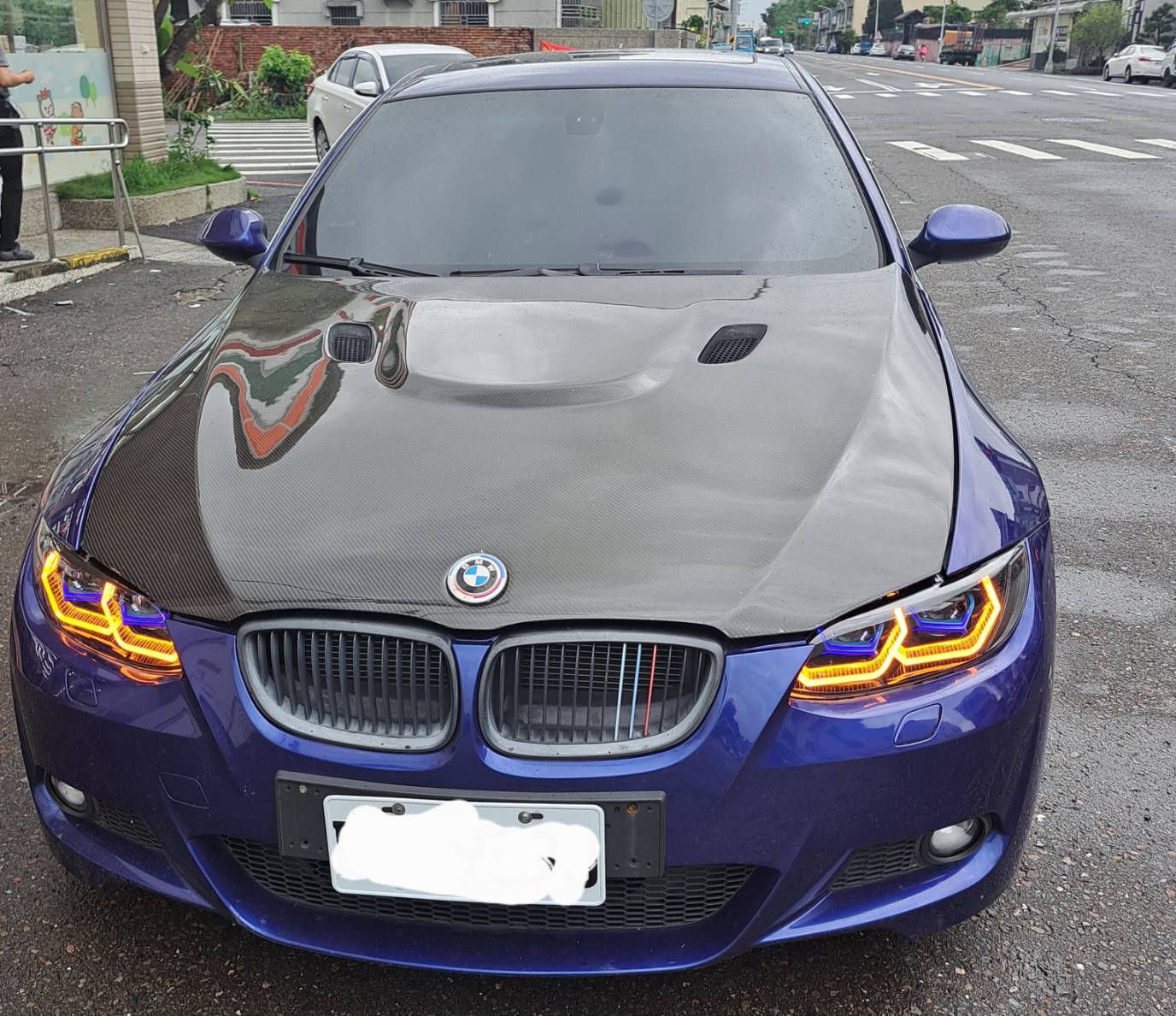كشفت تويوتا للتو عن أحدث نسخة من كامري، وهي سيارة سيدان بأربعة أبواب في كل مكان الآن في جيلها التاسع منذ أن دخلت السوق لأول مرة منذ أكثر من 40 عامًا في عام 1983. أحدث كامري، التي تم إطلاقها في عام 2018، هي الطراز الأكثر جرأة على الإطلاق وأكثر رياضية من أي كامري قبلها - لذا في أي اتجاه ستذهب تويوتا مع طرازها الجديد لعام 2024؟ على الرغم من اعتراف شركة صناعة السيارات نفسها، فإن أحدث طراز متوسط الحجم من تويوتا يمثل مراجعة كبيرة للطراز الحالي، لكنه حقق بعض القفزات المهمة إلى الأمام، بما في ذلك مجموعة من المحركات الهجينة النقية وشاشات العرض الداخلية الجديدة والتصميم الأكثر أناقة. لقد وضعنا كامري الجديدة جنبًا إلى جنب مع الإصدار المنتهية ولايته لتسليط الضوء على أكبر اختلافاتها من الداخل والخارج:
تويوتا كامري الجيل الثامن - منظر جانبي

بعد عدة سنوات من التطوير، عندما وصلت السيارة في عام 2018، كانت رياضية بشكل مدهش بالنسبة لسيارة كامري، وهو أمر رائع. ولكن في غضون خمس سنوات، أصبحت عادية تقريبًا إذا رأيت مئات الآلاف من هذه السيارات في الولايات المتحدة.S. الطرق. عند النظر إليها من الجانب، تمزج تويوتا كامري القادمة بين خطوط الجسم والإضاءة المعبرة مع الجزء الخلفي التقليدي المستقيم وخط غطاء المحرك المنحوت التقليدي تقريبًا. إنها سيارة سيدان بلا خجل، على الرغم من أنها تبدو أكثر إثارة للاهتمام من أي سيارة كامري قبلها.
تويوتا كامري الجيل التاسع - منظر جانبي

يسلط هذا المنظر الضوء بشكل كبير على مدى تشابه الجوانب السفلية لسيارة كامري الجديدة وكامري القديمة - فقط انظر إلى الأبواب الجانبية وخط السقف. إن كامري 2024 و 2025 متطابقتان بشكل أساسي، وهي علامة كلاسيكية على أن المركبتين تشتركان في بنية جسم أساسية. هذا لا يعني أن تويوتا لا تخفي عظام TNGA المعاد تدويرها جيدًا - على الرغم من الشكل المألوف، تبدو كامري الجديدة أكثر أناقة من الخارج بفضل بعض الحيل المرئية الذكية: المصابيح الخلفية الأرق، وزوايا المصد المشطوفة، يقوم غطاء المحرك الغارق وغطاء صندوق الأمتعة الأمامي والخلفي بالكثير من الرفع الثقيل لإحكام المظهر. تمتزج الأسطح الأكثر تقريبًا بشكل جيد مع طيات جانب الجسم الحادة، ويبدو أن طلاء كامري XSE القديم ثنائي اللون (مع سقف أسود) يتم الاحتفاظ به أيضًا كخيار في الطراز الجديد، كما ترى في الصورة أدناه.
الجيل الثامن من تويوتا كامري - المنظر الأمامي

إذا كان مظهر كامري القديمة يبدو عاديًا بعض الشيء، فإن أنفها ليس عاديًا على الإطلاق. قدمت تويوتا حزمتين أساسيتين للتصميم للجيل السابق من كامري، مع طرازي SE وXSE الرياضيين اللذين يتميزان بإعداد الشبك الأمامي المزخرف الموضح هنا، بينما لا تحتوي طرازات LE وWide ذات التصميم التقليدي على مداخل هواء إضافية في الزوايا. ضع جانبًا المألوف مرة أخرى، وتذكر عام 2018: إنه لأمر مذهل أن ترى سيارة كامري (هجينة أو غير ذلك) مع فتحات أنفها مغطاة بالكامل بشبك أمامي لدرجة أنها قد تجعل بورشه 911 GT3 تخجل. بالطبع، يتم إغلاق الكثير من الشبكة البلاستيكية السوداء (للحصول على ديناميكا هوائية أكثر سلاسة، ولنواجه الأمر، لا يحتاج محرك كامري إلى الكثير من التبريد)، لكن المظهر جريء بلا شك لسيارة سيدان متوسطة الحجم.
الجيل التاسع من تويوتا كامري - المنظر الأمامي

في السابق، يمكن الحصول على سيارة كامري 2025 بتصميمين أماميين منفصلين، مقسمين مرة أخرى إلى خطوط LE/XLE وSE/XSE. ومع ذلك، هناك تمايز أقل قليلاً من ذي قبل، حيث يشترك كلا الطرازين في المظهر الأساسي نفسه. فقط التفاصيل تغيرت. وهذا يعني أن كلا الإصدارين LE/XLE وSE/XSE لهما فتحات تهوية زاوية كبيرة على شكل حرف C كما هو الحال في XSE، بالإضافة إلى فتحات شبكية علوية رفيعة ومداخل هواء مركزية سفلية أكبر. ومع ذلك، فإن مداخل الهواء الزاوية في LE وXLE ليست عريضة، وتم استبدال نمط الشبكة الرياضية على الشبك المركزي الموضح أعلاه بشرائح أفقية أكثر تقليدية. تبدو كلتا السيارتين أنظف وأكثر فخامة من ذي قبل، مع إيماءات واضحة إلى سيارات تويوتا الأحدث الأخرى مثل سيارة سيدان كراون وأحدث سيارة هجينة من طراز بريوس، خاصة في المصابيح الأمامية النحيلة والعريضة. يمكننا أن نجازف بالقول إن معالجة الشبك تشبه تمامًا تلك الموجودة في لكزس، حيث إنها تحاكي تصميم الشبك المتدرج إلى المصد الموجود في أحدث سيارات الدفع الرباعي RX وTX.
تويوتا كامري الجيل الثامن - الشعار

كما تم تقسيم المظهر الخارجي لسيارة كامري السابقة حسب مستويات القطع، فإن شاراتها مقسمة حسب مجموعات نقل الحركة. اشترِ سيارة كامري تعمل بالبنزين (بمحرك I-4 سعة 2.5 لتر أو محرك V-6 سعة 3.5 لتر)، وستحصل على شارات تويوتا من الكروم الصلب على مقدمة ومؤخرة سيارتك السيدان. اختر الطراز الهجين وستأتي هذه الشارات بلمسات زرقاء. كما يحصل الطراز الهجين على شارة "HYBRID" على غطاء صندوق الأمتعة، مع خط متعرج صغير باللون الأزرق والكروم بجانبها.
تويوتا كامري الجيل التاسع - الشعار

حيث كانت الموديلات الهجينة فقط تحمل في السابق شعارات تويوتا الزرقاء في الأمام والخلف (كما كانت الحال مع جميع منتجات تويوتا الهجينة لسنوات)، فإن كامري الجديدة تلغي تلك الشارة تمامًا. بالطبع، هذا غريب، حيث لا يمكنك شراء كامري 2025 إلا بقوة هجينة. خيار محرك الغاز ميت. هل نحن من المجانين الذين يركزون كثيرًا على شارة كامري؟ ربما، لكن الشارات الجديدة تبدو أفضل - تشطيبها الفضي البسيط ومظهرها ثلاثي الأبعاد أكثر فخامة من قطع كامري القديمة، والتي كانت ذات مظهر بلاستيكي أسود، خاصة في المقدمة حيث تعمل الشارات كغطاء لمستشعر الرادار الموجي المليمتري لنظام مساعدة السائق. في كامري الجديدة، يبدو أن مجموعة المستشعرات هذه قد تم نقلها إلى مكان مخفي بشكل أفضل في فتحة الشبك العلوي الأرق.

لا تقلق، لا تحاول تويوتا إخفاء قوة كامري 2025 الهجينة، فهناك شارة "HEV" جديدة (تعني "مركبة كهربائية هجينة") على غطاء صندوق السيارة، مصحوبة بدائرة زرقاء صغيرة. تنتشر في جميع أنحاء المقصورة أحدث طرازات تويوتا الكهربائية، بما في ذلك بريوس برايم الهجينة القابلة للشحن وbZ4X EV.
الجيل الثامن من تويوتا كامري - المنظر الخلفي

هناك الكثير من التغييرات على الجزء الخلفي من سيارة Camry القديمة - أولها عنصر الناشر المزيف الذي يبرز من المصد السفلي. مرة أخرى، هذا هو تقليم SE الرياضي، ولكن كل سيارة Camry 2018-2024 تأتي مع إضاءة خلفية مائلة وطية تشبه الوشم على شكل دمعة تتساقط من كل مصباح خلفي. في طرازي SE وXSE، يوجد "فتحة تهوية" مزيفة داخل تلك الطية، مثل تلك التي تراها هنا. إذا كنا متشددين، فإن خط قطع المصد الخلفي يقع أمام كل طية/فتحة تهوية مباشرةً وهو شيء لا يمكنك تجاهله - لماذا لم تدمج تويوتا اللحامات في الحواف الأمامية لهذه الطيات؟ مفهوم. سنكافئ العادم المزدوج الكلاسيكي المكدس على الجانب الأيسر، على طراز BMW القديم، على الأقل في طراز SE رباعي الأسطوانات هذا. يتبنى طراز LE الأقل مواصفات تصميمًا أبسط للمصد السفلي ويخفي طرف العادم الفردي خلف هذه المكونات.
الجيل التاسع من تويوتا كامري - المنظر الخلفي

عند النظر من زاوية أخرى، فإن التقارب بين كامري العام الماضي وكامري الجديدة واضح أيضًا. إن ترتيب المصابيح الخلفية وغطاء صندوق الأمتعة وخطوط قطع الهيكل الرئيسية مألوف، ولكن تم تصميم كل مكون بعناية للحصول على مظهر أكثر تماسكًا. تم حل خط قطع المصد بشكل أفضل هنا، مع وجود مساحة كبيرة للتنفس بينه وبين الارتفاع الحاد في كل زاوية خلفية. عند النظر عن كثب، تحاكي المصابيح الخلفية شكل حرف C للمصابيح الأمامية، بينما تحاكي لوحة الترخيص أيضًا شكل الشبك السفلي المائل في المقدمة. يمنح التأثير العام الجزء الخلفي مظهرًا أكثر تسطحًا ومنحوتًا، بما يكفي حتى تتمكن تويوتا من نشر أحرف "CAMRY" على صندوق الأمتعة بشكل أوسع قليلاً والحفاظ على سطح المصد الرئيسي نظيفًا وبسيطًا.
تويوتا كامري الجيل الثامن - لوحة القيادة

تتميز سيارة تويوتا كامري القادمة بالعديد من لمسات التصميم الخارجي، انتظر حتى تجلس خلف عجلة القيادة. لوحة القيادة مليئة بالمنحنيات والزوايا ومفاتيح التشغيل والمواد غير المتطابقة. يوجد بلاستيك صلب محبب يبدأ من مستوى الركبة، ثم بلاستيك أكثر نعومة في الكونسول الوسطي، مع قسم رمادي فاتح على S- منحنى على شكل حرف V يمتد من حاملات الأكواب إلى مجموعة العدادات وحول فتحات التهوية. يوجد أيضًا بعض التنجيد المخيط أسفل كل فتحة تهوية جانبية، ومواد سوداء لامعة على لوحة التحكم في المناخ والشاشة التي تعمل باللمس، وأخيرًا يوجد بلاستيك أكثر نعومة أعلى لوحة القيادة. وفقًا لأسلوب تويوتا القديم، توجد أزرار تجاوزت عمرها الافتراضي بجيل أو جيلين (تلك القطع الأكثر سمكًا في مجموعة مفاتيح النافذة) مختلطة مع مفاتيح أحدث (مثل الأزرار الأصغر على لوحة التدفئة والتهوية وتكييف الهواء وحول شاشة اللمس) ، يتم الاحتفاظ بها لأنها غير تالفة - فلماذا تستبدلها؟ على نحو مماثل، لا تتطابق شاشة مجموعة العدادات الرقمية تمامًا مع الدقة أو نظام الألوان على شاشة اللمس المركزية. ومع ذلك، فإن لوحة القيادة ليست مملة على الإطلاق.
تويوتا كامري الجيل التاسع - لوحة القيادة

قامت تويوتا بتنظيف لوحة القيادة في كامري بشكل كبير هذه المرة، حيث قامت بتنعيم معظم الخطوط الأكبر حجمًا لاستيعاب مجموعة العدادات المستقيمة وشاشة اللمس. حتى عجلة القيادة بها أسلاك وأزرار مربعة. إذا نظرت عن كثب، ستلاحظ المزيد من "إنه ليس مكسورًا لذا لم نصلحه (تويوتا)!" يتم إعادة تدوير الأجزاء، وهي الجانب الأيسر من عجلة القيادة وصف الأزرار حول ذراع التروس، ولكن بقية لوحة القيادة جديدة بما يكفي لدرجة أنك ربما لن تلاحظ ذلك. تستبدل لوحة تكييف الهواء الأزرار الصغيرة على شكل الشوكولاتة في الجيل السابق من كامري المنتشرة عبر اللوحة المثلثة بأزرار أكبر قليلاً، والتي أصبحت الآن معبأة بإحكام معًا في صف أفقي ضيق. قدمت تويوتا بيئة العمل، وأخذت تويوتا بيئة العمل. تأتي سيارات كامري LE وSE الأساسية بمجموعة أدوات رقمية أصغر مقاس 7.0 بوصات وشاشة تعمل باللمس مقاس 8.0 بوصات، بينما تحصل طرازي XLE وXSE على وحدة أكبر مقاس 12.3 بوصة مصورة هنا.
تويوتا كامري الجيل الثامن - التصميم الداخلي

كما لاحظنا في اختبار المقارنة الأخير الذي أجريناه بين كامري القادمة ومنافستها هوندا أكورد في وقت سابق من هذا العام، فإن تويوتا مجهزة تجهيزًا جيدًا للغاية. لقد قمنا بإثارة كل هذه الأزرار للتحكم في عدد لا يحصى من ميزات الراحة التي لا توجد في معظم تشكيلات أكورد الجديدة. تتضمن الموديلات الهجينة أيضًا زر وضع EV خلف ناقل الحركة، والذي يقفل مجموعة نقل الحركة على دفعات قصيرة فقط بسرعات منخفضة، ولكن في الموديلات الهجينة العادية، يمكن تشغيل النظام بسرعات أسرع. يدخل تلقائيًا وضع EV بسرعة منخفضة. نموذج. مساحة المقعد الخلفي في كامري القديمة كافية، مع مساحة جيدة للأرجل (على الرغم من أنها ليست جيدة مثل أكورد) وارتفاع مقعد جيد. على عكس أحدث أكورد، تقدم كامري فتحات تهوية في المقعد الخلفي ومنافذ USB؛ تقتصر هذه التفاصيل على أكورد تورينج الرائدة في المجموعة - وهي خطيئة حقيقية لسيارة بهذا الحجم.
الجيل التاسع من تويوتا كامري - التصميم الداخلي

في حين أن كامري 2025 هي في الواقع كامري 2024 بقوة أحدث، فإننا نشك في أن المساحة الداخلية ستظل كما هي تقريبًا. ومع ذلك، فقد قفزت مستويات المعدات إلى الأمام قفزة كبيرة، خاصة من حيث المعيار. حتى طرازي كامري LE وSE الأساسيين يأتيان بشاشة لوحة العدادات الرقمية المذكورة أعلاه، إلى جانب التحكم في المناخ ثنائي المنطقة، وشاحن الهاتف اللاسلكي Qi، وعجلات ألومنيوم مقاس 16 بوصة، ومصابيح أمامية LED، ومفتاح ذكي مع بدء التشغيل بضغطة زر. يأتي SE بعجلات مقاس 18 بوصة، ونظام تعليق رياضي، وتنجيد مقاعد من الجلد الصناعي، وعجلة قيادة مغلفة بالجلد ودواسات من الألومنيوم. تتم ترقية XLE وXSE إلى عجلات مقاس 18 و19 بوصة على التوالي، بالإضافة إلى شاشة عدادات مقاس 12.3 بوصة وشاشة تعمل باللمس في المنتصف، ومصابيح خلفية LED، ومقاعد جلدية مدفأة وقابلة للتعديل كهربائيًا في الأمام، وإدخال مفتاح القرب، وعزل الصوت الأمامي والخلفي الزجاج الرقائقي. كما كان الحال من قبل، فإن مجموعة السلامة النشطة Safety Sense من Toyota هي قياسية في جميع الطرازات، وتتضمن الكبح التلقائي في حالات الطوارئ، ومراقبة النقطة العمياء، ومساعدة الحفاظ على المسار، والمصابيح الأمامية الأوتوماتيكية ذات الشعاع العالي، ونظام تثبيت السرعة التكيفي.
الجيل الثامن من تويوتا كامري - مجموعة نقل الحركة

إن تشكيلة سيارات كامري من تويوتا مليئة بالخيارات، فهناك في الواقع خطوط متوازية، واحدة تعمل بالغاز والأخرى هجينة. تعمل إصدارات البنزين الأساسية بمحرك I-4 سعة 2.5 لتر مقترن بناقل حركة أوتوماتيكي بثماني سرعات، ينتج 202 إلى 206 حصان و182 إلى 186 رطل قدم من عزم الدوران، حسب الطراز. يتوفر الدفع الرباعي فقط مع المحرك رباعي الأسطوانات. تويوتا استثناء، حيث تستمر في تقديم سيارات سيدان متوسطة الحجم بمحركات V-6 ذات السحب الطبيعي، في هذه الحالة محرك سعة 3.5 لتر ينتج 301 حصان و267 رطل قدم من عزم الدوران؛ يعد محرك V-6 هو الأكثر رياضية في طرازات كامري القياسية TRD.
تتميز سيارة كامري هايبرد، التي تقدم استهلاكًا أفضل للوقود مقارنة بنظيرتها التي تعمل بالبنزين فقط، بمحرك I-4 سعة 2.5 لتر مع زوج من المحركات الكهربائية وناقل حركة أوتوماتيكي متغير باستمرار يدور الإطارات الأمامية. يساهم محرك البنزين بقوة 176 حصانًا و163 رطلًا من عزم الدوران، بينما يضيف المحرك الكهربائي الرئيسي 118 حصانًا و149 رطلًا من عزم الدوران؛ أضف محركًا كهربائيًا ثالثًا (مولد التشغيل)، ليصل إجمالي خرج النظام إلى 208 أحصنة.
الجيل التاسع من تويوتا كامري - مجموعة نقل الحركة

قل وداعًا لمحركات I-4 وV-6 في كامري. لقد زادوا من إجمالي الناتج إلى 225 حصانًا بوحدة هجينة معدلة سعة 2.5 لتر. هذا الرقم للطاقة مخصص لسيارة تويوتا كامري ذات الدفع الأمامي لعام 2025. نحدد هذا لأن كامري هايبرد تأتي بنظام دفع رباعي اختياري لأول مرة. مثل معظم سيارات تويوتا الهجينة ذات الدفع الرباعي، يجمع هذا الإعداد بين النظام الهجين القياسي الذي يعمل على تشغيل المحور الأمامي ومحرك كهربائي ثالث منفصل على المحور الخلفي. يعزز المحرك الكهربائي للمحور الخلفي ناتج كامري هايبرد ذات الدفع الرباعي إلى 232 حصانًا ويوفر تعزيزًا للجر عند الطلب.
لماذا الهجين الكامل؟ بالإضافة إلى تبسيط التصنيع، فإن قرار تويوتا يتوافق مع تفكير منافستها هوندا بشأن أحدث طراز أكورد، والتي أسقطت محرك I-4 سعة 2.0 لتر بشاحن توربيني المتوفر في الإصدار الأقدم (خيار قوي يضم أيضًا منافسي كامري V-6) ووسعت عروضها الهجينة. مثل تويوتا، باعت هوندا سابقًا خطوط أكورد موازية، واحدة تعمل بالبنزين والأخرى هجينة. معظم مجموعة أكورد الآن هجينة، ولم يتبق سوى مستويين من القطع الأرخص مع خيارات المحرك ذات الناتج المنخفض لأكورد السابقة. يعد محرك تويوتا كامري الهجين الجديد لعام 2025 مطابقًا جيدًا لأكورد، حيث يتفوق بسهولة على رقم قوته البالغ 204 حصان ويعززه بشكل أكبر مع الدفع الرباعي الاختياري (هوندا هي دفع أمامي فقط).
هناك بعض التغييرات الكبيرة في قسم توليد القوة في تويوتا كامري الجديدة. لم تعد خيارات محرك I-4 و V-6 القديمة بسعة 2.5 لتر متاحة في الإصدارات التقليدية التي تعمل بالبنزين. في مكانها يوجد نظام هجين محسن بسعة 2.5 لتر يزيد من الناتج الإجمالي إلى 225 حصانًا. يجمع هذا النظام الهجين بين محرك I-4 سعة 2.5 لتر وزوج من المحركات الكهربائية وناقل حركة أوتوماتيكي متغير باستمرار للدفع بالعجلات الأمامية. في إصدارات الدفع بالعجلات الأمامية، يبلغ إجمالي ناتج النظام الهجين 225 حصانًا. بالإضافة إلى ذلك، تقدم كامري الجديدة أيضًا خيار الدفع الرباعي. تتميز إصدارات الدفع الرباعي بمحرك كهربائي ثالث إضافي مستقل عن نظام الدفع الأمامي، مما يمنح السيارة خرج طاقة أكبر وتعزيز الجر عند الطلب. تتمتع نسخة الدفع الرباعي بإجمالي ناتج نظام هجين يبلغ 232 حصانًا.
يعكس قرار تويوتا بالذهاب بنظام هجين كامل قرار منافستها هوندا بشأن أحدث طراز من أكورد. تخلت هوندا عن الإصدار الأقدم من محركها التوربيني I-4 سعة 2.0 لتر ووسعت مجموعتها الهجينة. كما اختارت تويوتا التخلي عن محركات البنزين التقليدية للتركيز على التكنولوجيا الهجينة. وذلك لتبسيط عملية التصنيع وتلبية احتياجات حماية البيئة وتوفير الوقود. يشبه النظام الهجين لسيارة كامري 2025 الجديدة نظام أكورد، لكنه يوفر أداءً أعلى من حيث توصيل الطاقة والدفع الرباعي.











